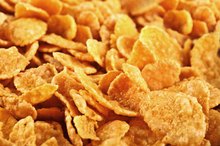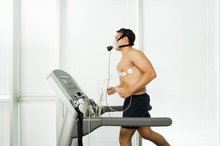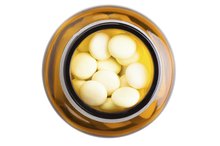Difference Between Anaerobic & Aerobic Muscle Contraction
Aerobic exercise generally refers to a low-intensity, endurance-type exercise such as walking, whereas anaerobic exercise refers to a high-intensity exercise such as sprinting. According to the Mayo Clinic, carbohydrates provide the fuel for exercise, and as exercise intensity increases, you need increasing amounts of carbohydrates to meet the higher energy demands of your muscles. Carbohydrates play a crucial role in generating energy during aerobic and anaerobic exercises.
Aerobic vs. Anaerobic
An aerobic condition is a state in which oxygen is present. During aerobic exercise, oxygen is exchanged for carbon dioxide in the blood, and oxygen is transported to your skeletal muscles via the blood supply. In contrast, an anaerobic condition is a state in which very little or no oxygen is present within the muscle. The amount of oxygen within a muscle determines what mechanism your muscle cells will use to produce energy.
Carbohydrates to Energy
Difference Between Anaerobic & Aerobic Muscle Contraction
Learn More
Carbohydrates, simply referred to as starches or sugars, are obtained from your diet and supplied to muscles via your blood. When carbohydrates enter your muscles, your body breaks them down to form a molecule called adenosine triphosphate, and ATP is the only molecule your body can use to directly generate energy for muscle contraction. Although carbohydrates are the common precursor used to generate ATP, the aerobic and anaerobic mechanisms to convert carbohydrates to ATP differ.
Aerobic Muscle Contraction
In the presence of oxygen, muscle cells use a process called oxidative phosphorylation to generate ATP to facilitate muscle contraction. This process can generate up to 32 ATP molecules per carbohydrate molecule available. While this process is slower than anaerobic energy production, it is able to meet your body's energy demands during a sustained, low-intensity workout. As long as oxygen remains available, your muscle cells will use oxidative phosphorylation to generate ATP; however, if oxygen content in the muscle is depleted, your muscle cells will switch to anaerobic ATP production.
Anaerobic Muscle Contraction
Carbohydrates & Respiration
Learn More
During high-intensity exercises, blood flow to your muscles is drastically reduced; therefore, inadequate oxygen will be delivered to the muscles. In the absence of oxygen, muscle cells use a process termed glycolysis to produce ATP. Glycolysis generates ATP much faster than oxidative phosphorylation; however, glycolysis can only yield two ATP per carbohydrate molecule available. Because glycolysis generates ATP much faster than oxidative phosphorylation, some muscles will resort to glycolysis even in the presence of oxygen to meet their energy needs at a faster rate. Although faster, one major consequence of glycolysis is the production of lactic acid which accumulates inside of your muscles to cause soreness and fatigue.
Related Articles
References
- Mayo Clinic: Carbohydrate-loading diet
- Human Physiology, Seventh Edition; Lauralee Sherwood
Writer Bio
This article was written by the CareerTrend team, copy edited and fact checked through a multi-point auditing system, in efforts to ensure our readers only receive the best information. To submit your questions or ideas, or to simply learn more about CareerTrend, contact us [here](http://careertrend.com/about-us).









